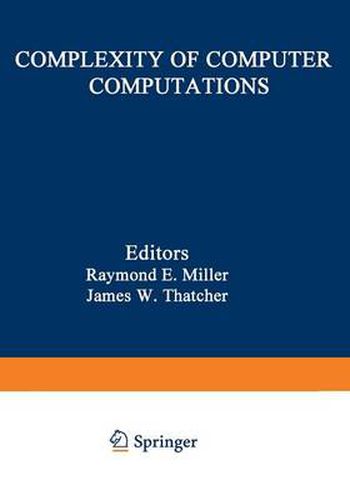Readings Newsletter
Become a Readings Member to make your shopping experience even easier.
Sign in or sign up for free!
You’re not far away from qualifying for FREE standard shipping within Australia
You’ve qualified for FREE standard shipping within Australia
The cart is loading…






This title is printed to order. This book may have been self-published. If so, we cannot guarantee the quality of the content. In the main most books will have gone through the editing process however some may not. We therefore suggest that you be aware of this before ordering this book. If in doubt check either the author or publisher’s details as we are unable to accept any returns unless they are faulty. Please contact us if you have any questions.
The Symposium on the Complexity of Computer Compu tations was held at the IBM Thomas J. Watson Research Center in Yorktown Heights, New York, March 20-22, 1972. These Proceedings contain all papers presented at the Symposium together with a transcript of the concluding panel discussion and a comprehensive bibliography of the field. The Symposium dealt with complexity studies closely re lated to how computations are actually performed on computers. Although this area of study has not yet found an appropriate or generally accepted name, the area is recognizable by the signif icant commonality in problems, approaches, and motivations. The area can be described and delineated by examples such as the following. (1) Determining lower bounds on the number of operations or steps required for computational solutions of specific problems such as matrix and polynomial calculations, sorting and other combinatorial problems, iterative com putations, solving equations, and computer resource allocation. (2) Developing improved algorithms for the solution of such problems which provide good upper bounds on the number of required operations, along with experimental and v vi PREFACE theoretical evidence concerning the efficiency and numer ical accuracy of those algorithms. (3) Studying the effects on the efficiency of computation brought about by variations in sequencing and the intro duction of parallelism.
$9.00 standard shipping within Australia
FREE standard shipping within Australia for orders over $100.00
Express & International shipping calculated at checkout
Stock availability can be subject to change without notice. We recommend calling the shop or contacting our online team to check availability of low stock items. Please see our Shopping Online page for more details.
This title is printed to order. This book may have been self-published. If so, we cannot guarantee the quality of the content. In the main most books will have gone through the editing process however some may not. We therefore suggest that you be aware of this before ordering this book. If in doubt check either the author or publisher’s details as we are unable to accept any returns unless they are faulty. Please contact us if you have any questions.
The Symposium on the Complexity of Computer Compu tations was held at the IBM Thomas J. Watson Research Center in Yorktown Heights, New York, March 20-22, 1972. These Proceedings contain all papers presented at the Symposium together with a transcript of the concluding panel discussion and a comprehensive bibliography of the field. The Symposium dealt with complexity studies closely re lated to how computations are actually performed on computers. Although this area of study has not yet found an appropriate or generally accepted name, the area is recognizable by the signif icant commonality in problems, approaches, and motivations. The area can be described and delineated by examples such as the following. (1) Determining lower bounds on the number of operations or steps required for computational solutions of specific problems such as matrix and polynomial calculations, sorting and other combinatorial problems, iterative com putations, solving equations, and computer resource allocation. (2) Developing improved algorithms for the solution of such problems which provide good upper bounds on the number of required operations, along with experimental and v vi PREFACE theoretical evidence concerning the efficiency and numer ical accuracy of those algorithms. (3) Studying the effects on the efficiency of computation brought about by variations in sequencing and the intro duction of parallelism.